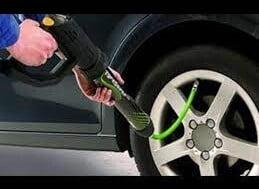all english artical in end
أهم المُصطلحات المُتعلقة بمواصفات السيارات الكهربائية والاختصارات المستخدمة لنصل للاختيار الأمثل والمناسب
1- torque
ويمثل عزم الدوران القادر على سحب حمولة السيارة بقوة في التسارع من السكون الى الحركة.
2- 90: Kw
ويمثل قدرة الموتور ومدى قوته …. وأحيانا يسأل البعض عن القدرة بالحصان وفى هذه الحالة يمكنك اخذ القيمة المذكورة كمثال (90/0.735=122 حصان)
3- Kw.h:
وتعبر عن سعة البطارية كل ما كانت سعتها اعلى كل ما زاد مدى سير السيارة الكهربائية ..
4-: suspension system
يسمى في مصر (العفشة) وهو المسؤول عن الثبات والتوازن في هيكل السياره وغرفة القيادة والمحافظ على ثبات السيارة على الطرقات والمنعطفات لتأمين راحة الركاب حيث يقوم بامتصاص الصدمات الناتجة عن عدم استواء الطريق ويمنع وصولها إلى غرفة القيادة.
5-: Anti-lock braking system (ABS)
هو نظام أمان يمنع توقف العجله عن الدوران إذ أن ذلك يمنع توجيه السيارة الكهربائيه أثناء الكبح الشديد فتنزلق إلى الأمام ولا يمكن التحكم فيها
6- Cruise control) مثبت السرعة)
نظام في السيارة يسمح للسائق بتحديد السرعة التي ستستمر بها السيارة الكهربائيه ما لم يغيرها السائق بالضغط على الفرامل أو دواسة القدره
7- Adaptive cruise control (ACC)
نظام التحكم في ثبات السرعةهو نظام مصمم لمساعدة المركبات في الحفاظ على مسافة آمنة فى حاله وجود سيارة أمامك والبقاء ضمن حدود السرعة فى حاله عدم وجود سياره امامك. يقوم هذا النظام بضبط سرعة السيارة تلقائيًا حتى لا يضطر السائقون إلى ذلك.
8- (EBD) electronic brake force distribution
يعد التوزيع الإلكتروني لقوة الفرامل ميزة فعالة في سلامة المركبات تم تصميمها لجعل الفرملة فعالة بأكبر قدر ممكن، إذ يقلل من مسافة التوقف وخطر الاصطدام عن طريق الموازنة التلقائية لقوة الفرامل المطبقة على كل عجلة وفقًا لتوزيع الوزن الإجمالي للسيارة، بل يمكنها أيضًا تخصيص المزيد من قوة الفرامل للعجلات التي تحتاج لقوة كبح أكبر.
10 – (TCS) traction control system
تعمل على عدم انزلاق السيارة عن مسارها الصحيح عند السير على الطرق المتعرجة او الطرق التى تتراكم بها مياة الامطار في فصل الشتاء او مياة المجارى فى معظم فصول وايام السنة، ويقوم هذا النظام بهذه المهمة جراء القوة الزائدة التي يتمتع بها، ويقوم النظام باستخدام هذه القوة من خلال الضغط على دواسة الوقود بشكل قوى جدا وفعال ويتبع النظام عدة طرق تدخل للسيطرة على السيارة عندما تتعرض للانزلاق على الطريق
11- (NEDC) – New European Driving Cycle
اختبار نظم القيادة الأوربية – وهو يعمل على قياس كفاءة استهلاك الطاقة للسيارات الهجين والسيارات الكهربائية … بمعنى أنه كلما قلت الطاقة المستخدمة لكل 100ك.م يدل ذلك على مدى كفاءة السيارة.
New Energy Technical Team
The most important terms related to the specifications of electric cars and the abbreviations used to arrive at the optimal and appropriate choice
1- torque
The torque capable of pulling the car’s load strongly represents the acceleration from rest to movement.
2- 90: Kw
It represents the power of the motor and its strength …. and sometimes some ask about the horsepower. In this case, you can take the mentioned value as an example (90/0.735 = 122 horsepower).
3- Kw.h:
It expresses the capacity of the battery, the higher its capacity, the greater the range of the electric car.
4-: suspension system
It is called in Egypt (Al Afsha), which is responsible for stability and balance in the car’s chassis and driving room, and maintains the stability of the car on roads and turns to ensure the comfort of passengers, as it absorbs shocks resulting from the unevenness of the road and prevents its access to the wheelhouse
5-: Anti-lock braking system (ABS)
It is a safety system that prevents the wheel from spinning, as this prevents the electric car from being steered during severe braking, so it slips forward and cannot be controlled.
6- Cruise control
A system in the car that allows the driver to set the speed at which the electric car will continue unless the driver changes it by pressing the brake or the power pedal
7- Adaptive cruise control (ACC)
Cruise control is a system designed to help vehicles maintain a safe distance in the event of a vehicle ahead and to stay within the speed limits when there is no vehicle ahead. This system automatically adjusts the vehicle’s speed so drivers don’t have to.
8- (EBD) electronic brake force distribution
Electronic Brake-force Distribution is an effective vehicle safety feature designed to make braking as efficient as possible. It reduces stopping distance and the risk of collision by automatically balancing the brake force applied to each wheel according to the vehicle’s overall weight distribution. It can even customize more braking force. For wheels that need more braking force.
10 – (TCS) traction control system
It works to prevent the car from slipping off its right path when traveling on winding roads or roads that accumulate rain water in the winter or sewage water in most seasons and days of the year, and this system performs this task due to the excess power it enjoys, and the system uses this force from By pressing the accelerator pedal very strongly and effectively, the system follows several methods that enter to control the car when it is slipping on the road
11- (NEDC) – New European Driving Cycle
European Driving Systems Test – It measures the energy efficiency of hybrid cars and electric cars…meaning that the less energy used per 100 km.m, this indicates how efficient the car is.
New Energy Technical Team
1- torque
The torque capable of pulling the car’s load strongly represents the acceleration from rest to movement.
2- 90: Kw
It represents the power of the motor and its strength …. and sometimes some ask about the horsepower. In this case, you can take the mentioned value as an example (90/0.735 = 122 horsepower).
3- Kw.h:
It expresses the capacity of the battery, the higher its capacity, the greater the range of the electric car.
4-: suspension system
It is called in Egypt (Al Afsha), which is responsible for stability and balance in the car’s chassis and driving room, and maintains the stability of the car on roads and turns to ensure the comfort of passengers, as it absorbs shocks resulting from the unevenness of the road and prevents its access to the wheelhouse
5-: Anti-lock braking system (ABS)
It is a safety system that prevents the wheel from spinning, as this prevents the electric car from being steered during severe braking, so it slips forward and cannot be controlled.
6- Cruise control
A system in the car that allows the driver to set the speed at which the electric car will continue unless the driver changes it by pressing the brake or the power pedal
7- Adaptive cruise control (ACC)
Cruise control is a system designed to help vehicles maintain a safe distance in the event of a vehicle ahead and to stay within the speed limits when there is no vehicle ahead. This system automatically adjusts the vehicle’s speed so drivers don’t have to.
8- (EBD) electronic brake force distribution
Electronic Brake-force Distribution is an effective vehicle safety feature designed to make braking as efficient as possible. It reduces stopping distance and the risk of collision by automatically balancing the brake force applied to each wheel according to the vehicle’s overall weight distribution. It can even customize more braking force. For wheels that need more braking force.
10 – (TCS) traction control system
It works to prevent the car from slipping off its right path when traveling on winding roads or roads that accumulate rain water in the winter or sewage water in most seasons and days of the year, and this system performs this task due to the excess power it enjoys, and the system uses this force from By pressing the accelerator pedal very strongly and effectively, the system follows several methods that enter to control the car when it is slipping on the road
11- (NEDC) – New European Driving Cycle
European Driving Systems Test – It measures the energy efficiency of hybrid cars and electric cars…meaning that the less energy used per 100 km.m, this indicates how efficient the car is.
New Energy Technical Team












